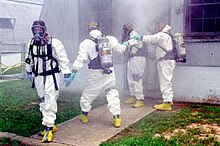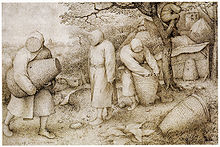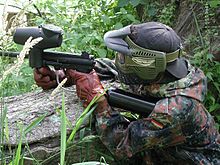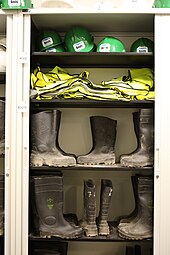Storex Family Sto-rex Leather and Craft Suppliers Western Mfg Co


Safety equipment and supervisor instructions at a construction site
Personal protective equipment (PPE) is protective clothing, helmets, goggles, or other garments or equipment designed to protect the wearer'due south torso from injury or infection. The hazards addressed by protective equipment include physical, electric, heat, chemicals, biohazards, and airborne particulate matter. Protective equipment may be worn for chore-related occupational safety and wellness purposes, as well as for sports and other recreational activities. Protective habiliment is applied to traditional categories of clothing, and protective gear applies to items such every bit pads, guards, shields, or masks, and others. PPE suits tin be similar in advent to a cleanroom suit.
The purpose of personal protective equipment is to reduce employee exposure to hazards when applied science controls and administrative controls are not feasible or effective to reduce these risks to acceptable levels. PPE is needed when there are hazards present. PPE has the serious limitation that information technology does not eliminate the hazard at the source and may result in employees beingness exposed to the run a risk if the equipment fails.[1]
Any detail of PPE imposes a barrier between the wearer/user and the working environment. This can create boosted strains on the wearer, impair their ability to carry out their work and create pregnant levels of discomfort. Any of these can discourage wearers from using PPE correctly, therefore placing them at risk of injury, ill-health or, under farthermost circumstances, death. Skillful ergonomic design can aid to minimise these barriers and can therefore help to ensure safe and salubrious working conditions through the correct employ of PPE.
Practices of occupational safety and health tin can utilise hazard controls and interventions to mitigate workplace hazards, which pose a threat to the safety and quality of life of workers. The hierarchy of adventure controls provides a policy framework which ranks the types of run a risk controls in terms of absolute gamble reduction. At the top of the bureaucracy are elimination and substitution, which remove the hazard entirely or supplant the risk with a safer alternative. If emptying or substitution measures cannot exist applied, engineering controls and authoritative controls – which seek to blueprint safer mechanisms and omnibus safer human behavior – are implemented. Personal protective equipment ranks last on the hierarchy of controls, as the workers are regularly exposed to the hazard, with a bulwark of protection. The bureaucracy of controls is important in acknowledging that, while personal protective equipment has tremendous utility, it is not the desired mechanism of control in terms of worker safe.
History

Early on PPE such as body armor, boots and gloves focused on protecting the wearer'due south body from physical injury. The plague doctors of sixteenth-century Europe also wore protective uniforms consisting of a full-length gown, helmet, drinking glass eye coverings, gloves and boots (see Plague doctor costume) to prevent contagion when dealing with plague victims. These were made of thick fabric which was then covered in wax to make it water-resistant. A mask with a beak-like construction was filled with pleasant-smelling flowers, herbs and spices to forbid the spread of miasma, the prescientific conventionalities of bad smells which spread disease through the air.[ii] In more than recent years, scientific personal protective equipment is more often than not believed to take begun with the material facemasks promoted by Wu Lien-teh in the 1910–11 Manchurian pneumonic plague outbreak, although many Western medics doubted the efficacy of facemasks in preventing the spread of affliction.[iii]
Types
Personal protective equipment can be categorized by the surface area of the body protected, by the types of hazard, and past the type of garment or accessory. A single item – for example, boots – may provide multiple forms of protection: a steel toe cap and steel insoles for protection of the feet from burdensome or puncture injuries, impervious safety and lining for protection from water and chemicals, high reflectivity and heat resistance for protection from radiant heat, and loftier electric resistivity for protection from electric shock. The protective attributes of each piece of equipment must exist compared with the hazards expected to exist constitute in the workplace. More breathable types of personal protective equipment may not lead to more than contagion but exercise result in greater user satisfaction.[iv]
Respirators


Respirators serve to protect the user from breathing in contaminants in the air, thus preserving the health of their respiratory tract. At that place are 2 main types of respirators. One type of respirator functions by filtering out chemicals and gases, or airborne particles, from the air breathed past the user.[5] The filtration may exist either passive or agile (powered). Gas masks and particulate respirators (like N95 masks)[six] are examples of this blazon of respirator. A second type of respirator protects users by providing clean, respirable air from another source. This type includes airline respirators and self-contained animate apparatus (SCBA).[5] In piece of work environments, respirators are relied upon when adequate ventilation is non available or other applied science control systems are non feasible or inadequate.[five]
In the United Kingdom, an system that has extensive expertise in respiratory protective equipment is the Institute of Occupational Medicine. This expertise has been built on a long-standing and varied inquiry programme that has included the setting of workplace protection factors to the assessment of efficacy of masks available through high street retail outlets.[ citation needed ]
The Health and Prophylactic Executive (HSE), NHS Health Scotland and Healthy Working Lives (HWL) accept jointly adult the RPE (Respiratory Protective Equipment) Selector Tool, which is web-based. This interactive tool provides descriptions of different types of respirators and breathing apparatuses, likewise as "dos and don'ts" for each type.[seven]
In the The states, The National Constitute for Occupational Rubber and Health (NIOSH) provides recommendations on respirator utilize, in accordance to NIOSH federal respiratory regulations 42 CFR Part 84.[5] The National Personal Protective Technology Laboratory (NPPTL) of NIOSH is tasked towards actively conducting studies on respirators and providing recommendations.[eight]
Surgical masks are considered as PPE, but are non considered equally respirators, being unable to terminate submicron particles from passing through, and likewise having unrestricted air flow at the edges of the masks.[6] [9]
Skin protection


This is an incorrect employ of personal protective equipment, because the gap between the glove and the lab glaze exposes the wrist to hazardous materials.
Occupational skin diseases such as contact dermatitis, skin cancers, and other pare injuries and infections are the second-most common type of occupational affliction and can be very costly.[10] Skin hazards, which lead to occupational skin disease, tin be classified into 4 groups. Chemical agents tin can come up into contact with the peel through directly contact with contaminated surfaces, deposition of aerosols, immersion or splashes.[10] Concrete agents such every bit extreme temperatures and ultraviolet or solar radiations can be damaging to the pare over prolonged exposure.[x] Mechanical trauma occurs in the form of friction, pressure, abrasions, lacerations and contusions.[10] Biological agents such as parasites, microorganisms, plants and animals can accept varied effects when exposed to the skin.[10]
Any form of PPE that acts equally a barrier between the skin and the agent of exposure can be considered skin protection. Because much work is washed with the hands, gloves are an essential particular in providing peel protection. Some examples of gloves unremarkably used as PPE include prophylactic gloves, cutting-resistant gloves, chainsaw gloves and heat-resistant gloves. For sports and other recreational activities, many different gloves are used for protection, generally against mechanical trauma.
Other than gloves, whatever other commodity of habiliment or protection worn for a purpose serve to protect the peel. Lab coats for example, are worn to protect against potential splashes of chemicals. Face up shields serve to protect one's face from potential affect hazards, chemical splashes or possible infectious fluid.
Many migrant workers need training in PPE for Heat Related Illnesses prevention (HRI). Based on study results, inquiry identified some potential gaps in rut prophylactic teaching. While some farm workers reported receiving express training on pesticide condom, others did non. This could be remedied by incoming groups of farm workers receiving video and in-person training on HRI prevention. These educational programs for farm workers are virtually effective when they are based on health behavior theories, use developed learning principles and employ railroad train-the-trainer approaches.[eleven]
Eye protection

A paintball actor wearing advisable eye protection confronting impact
Each mean solar day, about 2,000 Usa workers take a job-related centre injury that requires medical attending.[12] Center injuries tin happen through a diversity of means. Most eye injuries occur when solid particles such as metal slivers, wood chips, sand or cement chips get into the eye.[12] Smaller particles in smokes and larger particles such as broken glass also account for particulate affair-causing middle injuries. Blunt forcefulness trauma can occur to the center when excessive force comes into contact with the eye. Chemical burns, biological agents, and thermal agents, from sources such equally welding torches and UV light, as well contribute to occupational heart injury.[13]
While the required middle protection varies past occupation, the rubber provided tin can be generalized. Condom spectacles provide protection from external debris, and should provide side protection via a wrap-around design or side shields.[thirteen]
- Goggles provide improve protection than safety glasses, and are effective in preventing centre injury from chemical splashes, impact, dusty environments and welding.[13] Goggles with loftier air flow should be used to foreclose fogging.[13]
- Face shields provide additional protection and are worn over the standard eyewear; they also provide protection from touch, chemical, and blood-borne hazards.[13]
- Total-facepiece respirators are considered the best form of heart protection when respiratory protection is needed besides, but may be less effective against potential touch on hazards to the eye.[13]
- Eye protection for welding is shaded to dissimilar degrees, depending on the specific performance.[thirteen]
Hearing protection
Industrial noise is often disregarded as an occupational hazard, as it is non visible to the centre. Overall, about 22 1000000 workers in the United States are exposed to potentially damaging noise levels each twelvemonth.[fourteen] Occupational hearing loss deemed for 14% of all occupational illnesses in 2007, with about 23,000 cases significant plenty to cause permanent hearing impairment.[14] Most 82% of occupational hearing loss cases occurred to workers in the manufacturing sector.[14] In the US the Occupational Rubber and Wellness Administration establishes occupational noise exposure standards.[fifteen] The National Institute for Occupational Safety and Health recommends that worker exposures to noise be reduced to a level equivalent to 85 dBA for 8 hours to reduce occupational noise-induced hearing loss.[xvi]
PPE for hearing protection consists of earplugs and earmuffs. Workers who are regularly exposed to noise levels above the NIOSH recommendation should exist provided with hearing protection by the employers, equally they are a low-price intervention. A personal attenuation rating can be considerately measured through a hearing protection fit-testing organisation. The effectiveness of hearing protection varies with the training offered on their use.[17]
Protective wear and ensembles

Locker containing personal protective equipment

A complete PPE ensemble worn during high pressure cleaning work
This form of PPE is all-encompassing and refers to the diverse suits and uniforms worn to protect the user from harm. Lab coats worn past scientists and ballistic vests worn by law enforcement officials, which are worn on a regular basis, would fall into this category. Entire sets of PPE, worn together in a combined arrange, are also in this category.
Ensembles
Beneath are some examples of ensembles of personal protective equipment, worn together for a specific occupation or task, to provide maximum protection for the user.

- PPE gowns are used past medical personnel like doctors and nurses.
- Chainsaw protection (especially a helmet with face guard, hearing protection, kevlar chaps, anti-vibration gloves, and chainsaw safety boots).
- Bee-keepers wearable various levels of protection depending on the temperament of their bees and the reaction of the bees to nectar availability. At minimum about bee keepers wear a brimmed chapeau and a veil made of fine mesh netting. The next level of protection involves leather gloves with long gauntlets and some manner of keeping bees from crawling upwardly one's trouser legs. In farthermost cases, peculiarly fabricated shirts and trousers can serve as barriers to the bees' stingers.
- Diving equipment, for underwater diving, constitutes equipment such as a diving helmet or diving mask, an underwater breathing appliance, and a diving arrange.
- Firefighters wear PPE designed to provide protection against fires and various fumes and gases. PPE worn by firefighters include bunker gear, self-contained breathing apparatus, a helmet, safety boots, and a Pass device.
In sports
Participants in sports often wear protective equipment. Studies performed on the injuries of professional athletes, such every bit that on NFL players,[18] [19] question the effectiveness of existing personal protective equipment.
Limits of the definition

Workers using personal protective equipment while painting poles. While basic head protection is present, no engineering science fall protection systems announced to exist in place.
The definition of what constitutes personal protective equipment varies by state. In the The states, the laws regarding PPE likewise vary past state. In 2011, workplace safety complaints were brought against Hustler and other developed film product companies by the AIDS Healthcare Foundation, leading to several citations brought past Cal/OSHA.[20] The failure to use condoms past developed moving picture stars was a violation of Cal/OSHA's Blood borne Pathogens Program, Personal Protective Equipment.[20] This instance shows that personal protective equipment can cover a variety of occupations in the United States, and has a wide-ranging definition.
Standardization
| | This section is empty. You can aid by adding to it. (September 2021) |
Legislation
United states of america
| | This section is empty. You can assistance by adding to it. (September 2021) |
Eu
At the European Union level, personal protective equipment is governed by Directive 89/686/EEC on personal protective equipment (PPE). The Directive is designed to ensure that PPE meets common quality and safe standards by setting out basic safety requirements for personal protective equipment, as well every bit weather condition for its placement on the market and free movement within the European union single market. Information technology covers "whatever device or appliance designed to exist worn or held by an individual for protection confronting one or more health and safety hazards".[21] The directive was adopted on 21 Jan 1989 and came into force on 1 July 1992. The European Commission additionally allowed for a transition period until 30 June 1995 to give companies sufficient time to adapt to the legislation. After this engagement, all PPE placed on the market in EU Member States was required to comply with the requirements of Directive 89/686/EEC and behave the CE Marking.
Article i of Directive 89/686/EEC defines personal protective equipment equally whatever device or appliance designed to be worn or held past an individual for protection confronting one or more health and safe hazards. PPE which falls under the scope of the Directive is divided into iii categories:
- Category I: simple design (e.g. gardening gloves, footwear, ski goggles)
- Category II: PPE non falling into category I or III (e.g. personal flotation devices, dry out and wet suits, motorcycle personal protective equipment)
- Category III: complex design (due east.g. respiratory equipment, harnesses)
Directive 89/686/EEC on personal protective equipment does non distinguish between PPE for professional use and PPE for leisure purposes.
Personal protective equipment falling within the scope of the Directive must comply with the bones health and safety requirements set out in Annex Ii of the Directive. To facilitate conformity with these requirements, harmonized standards are developed at the European or international level past the European Committee for Standardization (CEN, CENELEC) and the International Organisation for Standardization in relation to the design and industry of the product. Usage of the harmonized standards is voluntary and provides presumption of conformity. However, manufacturers may choose an alternative method of complying with the requirements of the Directive.
Personal protective equipment excluded from the scope of the Directive includes:
- PPE designed for and used past the military machine or in the maintenance of law and lodge;
- PPE for cocky-defence (east.g. aerosol canisters, personal deterrent weapons);
- PPE designed and manufactured for personal use against adverse atmospheric conditions (e.m. seasonal wearable, umbrellas), damp and h2o (e.g. dish-washing gloves) and rut;
- PPE used on vessels and aircraft merely not worn at all times;
- helmets and visors intended for users of 2- or three-wheeled motor vehicles.
The European Commission is currently working to revise Directive 89/686/EEC. The revision will expect at the scope of the Directive, the conformity cess procedures and technical requirements regarding marketplace surveillance. It will too marshal the Directive with the New Legislative Framework. The European Commission is likely to publish its proposal in 2013. It will and so be discussed by the European Parliament and Council of the European Union under the ordinary legislative procedure before being published in the Official Periodical of the European union and becoming constabulary.
Research
Research studies in the form of randomized controlled trials and simulation studies are needed to determine the most effective types of PPE for preventing the transmission of infectious diseases to healthcare workers.[4]
There is low certainty evidence that supports making improvements or modifications to PPE in order to help decrease contamination.[iv] Examples of modifications include adding tabs to masks or gloves to ease removal and designing protective gowns so that gloves are removed at the same fourth dimension.[4] In addition, there is low certainty evidence that the following PPE approaches or techniques may lead to reduced contagion and improved compliance with PPE protocols: Wearing double gloves, following specific doffing (removal) procedures such as those from the CDC, and providing people with spoken instructions while removing PPE.[4]
Run into also
- Biological hazard – Biological textile that poses serious risks to the health of living organisms
- Blunt trauma personal protective equipment
- Flop disposal – Activity to dispose of and render safe explosive munitions and other materials
- CBRN defense – Protective measures against chancy materials warfare (Chemical Biological Radiological Nuclear, known formerly as NBC)
- Chainsaw safe clothing – Personal protective equipment for operators of chainsaws
- Chemic protective clothing
- Ecology suit – Wear worn to protect a person in a hostile surroundings
- Fall arrest – Equipment which safely stops a person already falling
- Hard hat – Helmet type
- Hazmat – Solids, liquids, or gases harmful to people, other organisms, property or the environs (chancy materials)
- High-visibility clothing – Condom wear
- Motorcycle personal protective equipment
- NBC suit – Blazon of armed forces personal protective equipment
- Personal flotation device – Equipment to aid the wearer keep afloat in water
- Personal protective equipment for arc flash – Heat and light produced during an electrical arc fault
- PPE Portrait project – Way to humanize medical staff wearing PPE
- Prophylactic handling of hazardous drugs
- Condom harness – Equipment designed to protect from falling
- Usage of personal protective equipment
- Workplace run a risk controls for COVID-19 – Prevention measures for COVID-xix
- Normalization of deviance – one reason people stop using effective prevention measures
References
- ^ "Personal Protective Equipment". Citation PLC. Archived from the original on 2012-10-14. Retrieved 2012-10-31 . Personal Protective Equipment
- ^ Funderburk, Greg; McGowan, Dennis; Stumph, Charles (2015). Weapons of Mass Destruction. LawTech Publishing Group. ISBN978-1-56325-283-9.
- ^ Lynteris, Christos (xviii August 2018). "Plague Masks: The Visual Emergence of Anti-Epidemic Personal Protection Equipment". Medical Anthropology. 37 (half dozen): 442–457. doi:10.1080/01459740.2017.1423072. ISSN 0145-9740. PMID 30427733.
- ^ a b c d east Verbeek, Jos H; Rajamaki, Blair; Ijaz, Sharea; Sauni, Riitta; Toomey, Elaine; Blackwood, Bronagh; Tikka, Christina; Ruotsalainen, Jani H; Kilinc Balci, F Selcen (2020-05-xv). "Personal protective equipment for preventing highly infectious diseases due to exposure to contaminated torso fluids in healthcare staff". Cochrane Database of Systematic Reviews. 2020 (5): CD011621. doi:x.1002/14651858.cd011621.pub5. hdl:1983/b7069408-3bf6-457a-9c6f-ecc38c00ee48. ISSN 1465-1858. PMC8785899. PMID 32412096.
- ^ a b c d Respirators Archived 2012-08-thirty at the Wayback Machine. National Constitute for Occupational Safety and Health.
- ^ a b "N95 Respirators and Surgical Masks (Face Masks)". United States Food and Drug Administration. 5 April 2020. Retrieved xviii Apr 2020.
- ^ "Selecting the right Respiratory Protective Equipment (RPE) for the chore". Healthy Working Lives. 2008-four-4
- ^ CDC - NIOSH - Respirator Fact Canvass Archived 2017-09-28 at the Wayback Motorcar. The National Personal Protective Technology Laboratory.
- ^ "Respiratory Protection Against Airborne Infectious Agents for Health Intendance Workers: Do surgical masks protect workers?" (OSH Answers Fact Sheets). Canadian Heart for Occupational Health and Safety. 2017-02-28. Retrieved 2020-04-18 .
- ^ a b c d east CDC - Pare Exposures and Effects - NIOSH Workplace Rubber and Health Topic Archived 2012-08-06 at the Wayback Machine. The National Found for Occupational Safety and Health.
- ^ Luque, John S. (2019). ""I Think the Temperature was 110 Degrees!": Work Rubber Discussions Amid Hispanic Farmworkers". Periodical of Agromedicine. 24 (1): 15–25. doi:x.1080/1059924x.2018.1536572. PMC7045709. PMID 30317928.
- ^ a b CDC - Eye Safety - NIOSH Workplace Safety and Health Topic Archived 2017-07-07 at the Wayback Machine. The National Institute for Occupational Safety and Health.
- ^ a b c d e f k CDC - Heart Safety - Eye Safety for Emergency Response and Disaster Recovery Archived 2017-09-02 at the Wayback Auto. The National Institute for Occupational Safety and Wellness.
- ^ a b c CDC - Noise and Hearing Loss Prevention - Facts and Statistics - NIOSH Workplace Safety and Health Topic Archived 2016-07-03 at the Wayback Machine. The National Found for Occuaptional Safety and Health.
- ^ Occupational noise exposure - 1910.95 Archived 2015-04-02 at the Wayback Machine. The Occupational Safety and Health Administration.
- ^ Criteria for a Recommended Standard: Occupational Dissonance Exposure Archived 2017-02-02 at the Wayback Machine. DHHS (NIOSH) Publication No. 98-126.
- ^ Tikka, Christina; Verbeek, Jos H; Kateman, Erik; Morata, Thais C; Dreschler, Wouter A; Ferrite, Silvia (2017-07-07). "Interventions to forestall occupational dissonance‐induced hearing loss". The Cochrane Database of Systematic Reviews. 2017 (7): CD006396. doi:x.1002/14651858.CD006396.pub4. ISSN 1469-493X. PMC6353150. PMID 28685503.
- ^ CDC - NIOSH Science Blog - Brain Injury in the NFL Archived 2012-12-twenty at Wikiwix. The National Establish for Occupational Prophylactic and Health.
- ^ Lehman, EJ; Hein, MJ; Baron, SL; Gersic, CM (2012). "Neurodegenerative causes of death amongst retired National Football League players". Neurology. 79 (19): 1970–4. doi:10.1212/WNL.0b013e31826daf50. PMC4098841. PMID 22955124.
- ^ a b "Larry Flynt's Hustler Video Cited past Cal/OSHA over Condoms, Safety, Says AHF". businesswire.com. 2011-03-31. Archived from the original on 6 August 2016. Retrieved 6 May 2018.
- ^ "Council Directive 89/686/EEC of 21 December 1989 on the approximation of the laws of the Member States relating to personal protective equipment". europa.eu. 30 December 1989. Retrieved 6 May 2018.
External links
- CDC - Emergency Response Resources: Personal Protective Equipment - NIOSH Workplace Prophylactic and Wellness Topic
- European Commission, DG Enterprise, Personal Protective Equipment
- Directive 89/686/EEC on Personal Protective Equipment
- A short guide to the Personal Protective Equipment at Work Regulations 1992' INDG174(rev1), revised viii/05 (HSE)
Source: https://en.wikipedia.org/wiki/Personal_protective_equipment
0 Response to "Storex Family Sto-rex Leather and Craft Suppliers Western Mfg Co"
Post a Comment